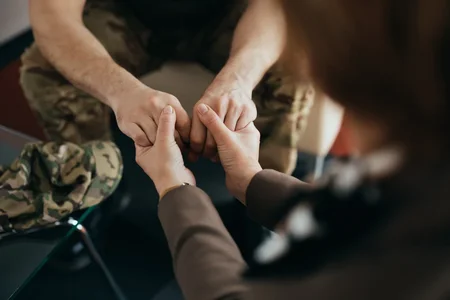5 min read
Last updated 9/14/22
Suicide Prevention Awareness: Myths vs. Facts

Melissa Leeth, M.A.

Common Suicide Myths Debunked
As a mental health therapist, I have shared sacred therapeutic space with clients struggling with relentless, terrifying suicidal thoughts. I have been honored to walk alongside clients as they gain renewed hope, a sense of purpose, and reason to live.
Clients’ reasons to live may be to attend a child’s graduation, to have the opportunity to go on a long-awaited vacation, or to sit beside the ocean and see the waves come and go. To be a part of the ebb and flow of emotions that are indicative of the living, breathing human experience.
Through my clinical work, I have gained an appreciation for the diverse range of reactions that people may have in response to the highly sensitive topic of suicide. No matter the response, I am always appreciative that a conversation is happening. A conversation opens the door to allow for further exploration.
For some, the topic of suicide may seem more far removed and distant from their perspective. They may make statements like “Suicide wouldn’t happen here” and “Suicide’s not an issue for me or my family or my friends.” There is such a deep desire amongst all of us to feel a strong sense of safety. However, it is very important to note that suicide is a possibility no matter a person’s gender, age, socioeconomic status, geographic location, educational level, career type, etc.
Given suicide could very well impact anyone of us and/or our loved ones, we all need to stay informed on the topic of suicide. Read on to learn more about the common myths and facts surrounding suicide.
MYTH: “SUICIDE ISN’T A BIG DEAL; IT DOESN’T HAPPEN ALL THAT OFTEN.”
The American Foundation for Suicide Prevention (AFSP) reports suicide is the 12th leading cause of death in the U.S. Based on data from 2020, 45,979 Americans died by suicide and there was an estimated 1.2 million suicide attempts. On average, there were 130 suicides per day.
MYTH: “SUICIDE ISN’T PREVENTABLE.”
According to the Centers for Disease Control and Prevention (CDC), suicide is preventable. The CDC notes that preventing suicide requires implementing prevention and protective strategies at all levels of society: at the individual level, within families, and in the greater community.
MYTH: “ASKING SOMEONE IF THEY ARE SUICIDAL WILL MAKE THEM SUICIDAL.”
Having a conversation about suicide can be absolutely critical and lifesaving. By simply asking a loved one if they are having thoughts of suicide, you are not “planting the seed” of suicide; instead, you are expressing concern and offering support.
The National Alliance on Mental Illness (NAMI) provides the following tips on how to start a conversation about suicide:
- Lean In.
- Share your observations and concerns.
- Know Your Resources.
- Become familiar with your local community mental health resources as well as national crisis support services such as the 988 Suicide & Crisis Lifeline.
- Ask Open-Ended Questions.
MYTH: “EXPRESSING SUICIDAL THOUGHTS OR PLANS IS ATTENTION-SEEKING BEHAVIOR. IT’S BEST NOT TO GIVE THE PERSON WITH SUICIDAL THOUGHTS OR PLANS ANY TIME OR ATTENTION, IT’LL ONLY MAKE THINGS WORSE.”
Regardless of a person’s motivation, it is best practice to take every suicidal expression seriously. The National Institute of Mental Health (NIMH) reports “Suicidal thoughts or actions are a sign of extreme distress and an indicator that someone needs help. Talking about wanting to die by suicide is not a typical response to stress. All talk of suicide should be taken seriously and requires immediate attention.”
MYTH: “IT DOESN’T MATTER IF THERE ARE FIREARMS OR OTHER LETHAL WEAPONS THAT ARE EASILY ACCESSIBLE IN THE HOME. IF THERE IS A DESIRE TO DIE, SUICIDE WILL HAPPEN. I SHOULDN’T HAVE TO CHANGE MY LIFESTYLE FOR SOMEONE ELSE.”
It absolutely does matter if there is an accessible firearm in the home of someone struggling with suicidality. There is a relationship between firearm access and suicide rate.
According to statistics from Prevent Firearm Suicide, firearms are used in half of all suicide deaths. Suicides make up three in every five gun deaths. Suicide by firearm is almost always deadly; 9 out of 10 firearm suicide attempts result in death. 64 Americans die by firearm suicide everyday or one every 22 minutes. In 2019, 23,941 Americans died by firearm suicide.
Prevent Firearm Suicide suggests the following safe storage options:
- “Store firearms unloaded and locked
- Store and lock ammunition separately from firearms
- Ensure the key and/or combination is inaccessible to the person at risk of suicide
- Temporarily remove firearms from your home.”
MYTH: “SUICIDE WON’T HAPPEN TO MY FRIENDS. THEY ARE BUSY, HIGH ACHIEVING COLLEGE STUDENT-ATHLETES.”
A 2016 article reports that suicide is the third leading cause of death among college-aged individuals and is reported as the second leading cause of death among the general college student population.
Although thoughts of suicide can affect anyone, Substance Abuse and Mental Health Services Administration (SAMHSA) notes there are certain populations that are at greater risk of suicide than others. These populations include: adults over the age of 45, American Indians, Alaskan Natives, veterans, LGBTQ+, youth and young adults, attempt survivors, loss survivors, and disaster survivors.
MYTH: “A FRIEND SAYS THINGS LIKE “I CAN’T HANDLE LIFE ANYMORE.” AS LONG AS THEY DON’T SAY THE PHRASE “I WANT TO DIE,” THEY AREN’T ACTUALLY SUICIDAL. I DON’T NEED TO LET ANYONE KNOW ABOUT THEIR ISSUES, IT’S NOT MY BUSINESS.”
Suicidal expressions can come in many forms and may not include a crystal clear statement of “I want to die.” When observing or learning of concerns made by a loved one, it is best to check in with them and offer support.
The Mayo Clinic suggests several helpful ways to offer support:
- Encourage the person to contact a suicide hotline number.
- In the U.S., call or text 988 to reach the 988 Suicide & Crisis Lifeline.
- Encourage the person to seek medical and/or mental health treatment.
- If the person is not interested in seeking consultation with a doctor or participating in mental health treatment, suggest finding help from a support group, crisis center, faith community, teacher, or other trusted person.
- Offer to help the person gain assistance and support.
- For example, collaboratively research treatment options, make phone calls, review insurance benefit information, or offer to go with the person to an appointment.
- Encourage communication.
- Be respectful; acknowledge the person’s feelings.
- Don’t patronize or place judgment.
- Never promise to keep suicidal feelings a secret.
- Offer hope that things can get better.
- Encourage avoidance of alcohol and drug use.
- If possible, remove potentially dangerous items from the person’s home.
Now that we have reviewed several myths and facts about suicide, I hope you feel more knowledgeable and equipped to discuss this sensitive topic. The most important thing to keep in mind when helping a loved one struggling with suicidal thoughts is that safety is always the top priority.
Keep in mind, if you or your loved one are in crisis, 911 can be contacted for medical emergencies and 988 can be contacted for mental health emergencies.
For a non-emergency situation, it is best to seek professional medical and/or mental health care. If you have a positive relationship with your primary care physician or other physicians, ask them for a referral for mental health services. If your child is seeing a pediatrician, ask them where they can go to receive mental health services. Mental health services can be truly life-changing, lifesaving care.
References
988 Suicide & Crisis Lifeline. Retrieved from: https://988lifeline.org/
American Foundation for Suicide Prevention (AFSP). Retrieved from: https://afsp.org/suicide-statistics/
Centers for Disease Control and Prevention (CDC). Retrieved from: https://www.cdc.gov/suicide/prevention/index.html
“How to Ask Someone About Suicide.” National Alliance on Mental Illness (NAMI). Retrieved from: https://www.nami.org/Blogs/NAMI-Blog/September-2019/How-to-Ask-Someone-About-Suicide
National Institute on Mental Health (NIMH). Retrieved from: https://www.nimh.nih.gov/health/publications/suicide-faq
People at Greater Risk of Suicide. Substance Abuse and Mental Health Services Administration (SAMHSA). Retrieved from: https://www.samhsa.gov/suicide/at-risk
Prevent Firearm Suicide. Retrieved from: https://preventfirearmsuicide.efsgv.org/about-firearm-suicide/statistics/
Rao, A. L., & Hong, E. S. (2016). Understanding depression and suicide in college athletes: emerging concepts and future directions. British Journal of Sports Medicine, 50(3), 136-137. http://dx.doi.org/10.1136/bjsports-2015-095658
Suicide: What to do when someone is suicidal. Mayo Clinic. Retrieved from: https://www.mayoclinic.org/diseases-conditions/suicide/in-depth/suicide/art-20044707
